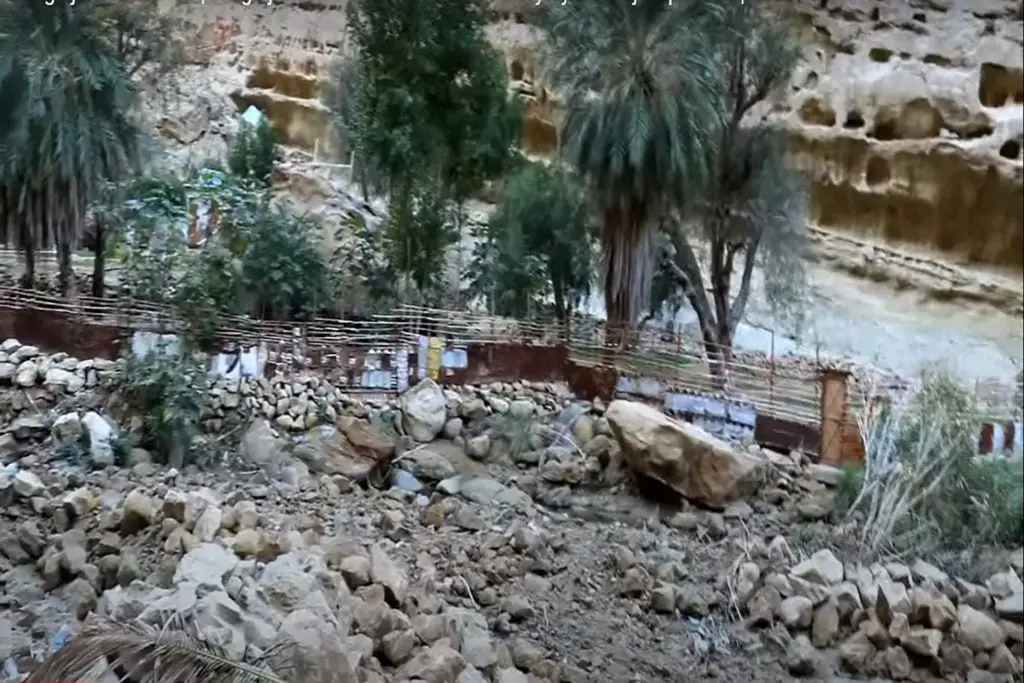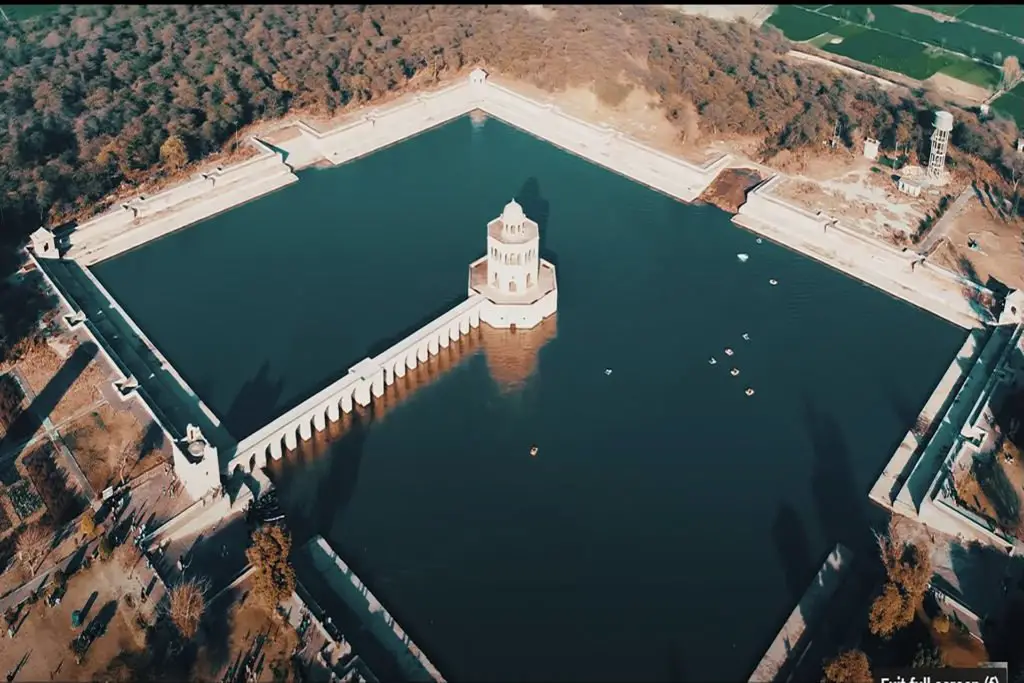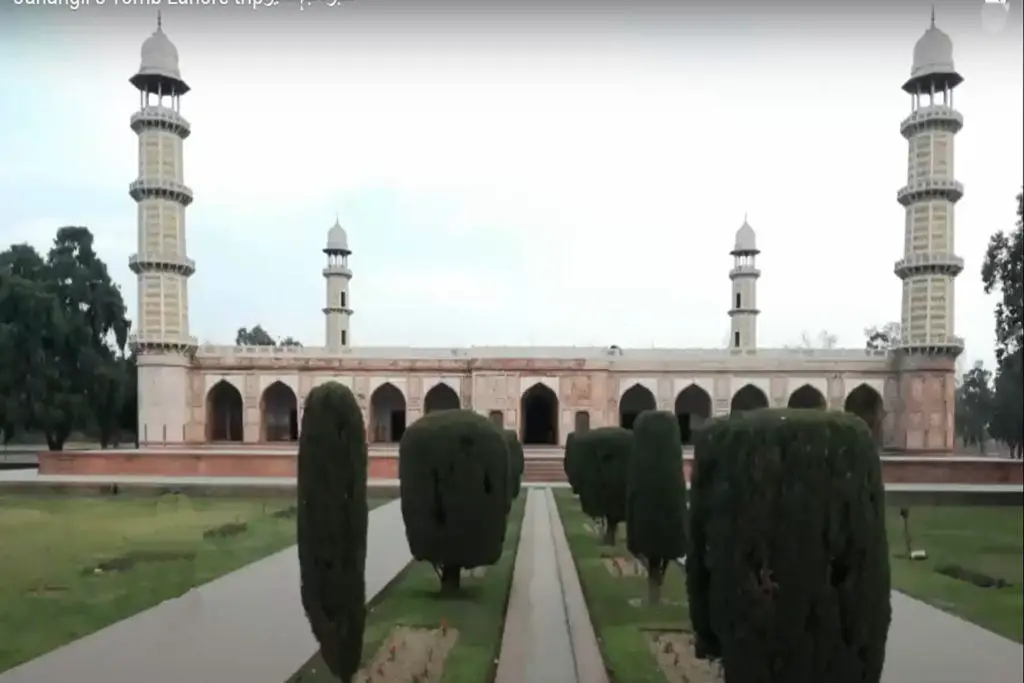Hinglaj Mata or Hinglaj Devi, Hingula Devi or Nani Mandir is a Hindu temple in Hinglaj and is known as Devi Hinglaj Mata Mandir Balochistan.
Hinglaj is a coastal town of Makran in the Lasbela district of Balochistan and is in the middle of Hingol National Park. It is one of the 51 Shakti Peethas in the Shaktism denomination of Hinduism.
It is one of the three Shakti Peethas in Pakistan, the other two are Shivaharkaray and Sharada Peeth. It is a form of Durga or Devi in a mountain cave on the shores of the Hingol River.
Over the past three decades, the popularity of Devi Hinglaj Mata Mandir Balochistan has increased and has become a regular visiting area for Pakistan’s Hindu communities. Hinglaj Yatra is the largest Hindu pilgrimage in Pakistan. More than 250,000 Hindu devotees participate in the Hinglaj Yathra during peak season.
The temple or Mandir (Urdu) is in a small natural cave. There is a low clay altar. There is no man-made image of the goddess. A small divine form of Hinglaj Mata is worshipped. The stone is smeared with sindoor (vermilion), possibly giving the locality its Sanskrit name Hingula, which is the root of the present name Hinglaj.
Devi Hinglaj Mata Mandir Balochistan Location
The cave temple of Hinglaj Mata is located in a narrow gorge in the remote hilly area of Lyari Tehsil in Balochistan. It is 250 kilometers (160 mi) to the northwest, 12 miles (19 km) inland from the Arabian Sea, and 80 miles (130 km) west of the Indus. It is at the end of the Kirthar Mountains, in the Makran desert section, on the west bank of the Hingol River. The area is in the Hingol National Park.
Hinglaj Mata is an important area for different communities and not only the Hindus. In earlier times, access to the temple was very difficult, but now after the construction of the Makran Coastal Highway, the number of visitors has considerably increased as travel time from Karachi has reduced to around 3 to 3.5 hours.
For many pilgrims, according to the writer, the preference was a pilgrimage on foot as many of them believe that the more pain they would go through to reach the temple, the more goodness they would get from the goddess.
Other places of worship in and around Hinglaj are Ganesh Deva, Mata Kali, Gurugorakh Nath Dooni, Braham Kudh, Tir Kundh, Gurunanak Kharao, Ramjarokha Bethak, Aneel Kundh On Chorasi Mountain, Chandra Goop, Kharriver and Aghore Pooja.
Hinglaj Mata History and Hindu Beliefs
As per Hindu Beliefs, Hinglaj Mata is said to be a very powerful deity who bestows goodness on all her devotees. While Hinglaj is her main temple, temples dedicated to her exist in the neighboring Indian states of Gujarat and Rajasthan.
The temple is known as Hingula, Hingalaja, Hinglaja, and Hingulata in Hindu scriptures, especially in Sanskrit. The goddess is known as Hinglaj Mata (Mother Hinglaj), Hinglaj Devi (Goddess Hinglaj), Hingula Devi (Red Goddess or Goddess Hingula), and Kottari or Kotavi.
The main legend of Hinglaj Mata relates to the creation of Shakti Peethas. Sati, the daughter of Prajapati Daksha, was married to the god Shiva against his will. Daksha organized a great yajna but did not invite Sati and Shiva. Uninvited, Sati reached the Yajna site where Daksha ignored Sati and insulted Shiva. Unable to withstand this insult, Sati sacrificed herself by activating her chakras (energy generated by her anger).
Sati died but her body did not burn. Shiva (as Virabhadra) killed Daksha for being responsible for Sati’s death and forgave him, resurrecting him. A wild, grief-stricken Shiva roamed the universe with Sati’s corpse. Finally, Lord Vishnu cut Sati’s body into 108 parts, of which 52 fell on Earth and the rest on other planets in the universe, which became Shakti Peethas, the temple of the goddess form.
Shiva is also worshiped at each Shakti Pitha in the form of Bhairava, the male counterpart or guardian of the presiding Pitha goddess. Sati’s head is believed to have fallen on Hinglaj.
The Kularnava Tantra mentions 18 Pithas and mentions Hingula as the third. In the Kubjika Tantra, Hingula is listed among the 42 Shaktas or Siddha Pithas, in which Hinglaj ranks fifth.
The Pithanirnaya or Mahapithanirupana section of the Tantrachudamani originally listed 43 names, but names were added over time, making them 51 Pithas. It describes in detail the Pitha-devata or Devi (the name of the goddess in the Pitha), the Kshastradishas (Bhairava), and the anga-pratyanga (the limbs including the ornaments of Sati).
Hingula or Hingulata is the first in the list, the anga-pratyanga being the Brahmarandhra (seam at the top of the head). Devi is known by several names such as Kottari, Kottavi, Kottarisha, and Bhairava is Bhimalochana. In Shivasharitha, Hingula is again first in the list of 55 Pithas.
Brahmarandhra is anga-pratyanga, the goddess is called Kottari and Bhairava is Bhimalochana (located in Koteshwar).
Oldest Mandir in Balochistan
In the 16th-century non-biblical Bengali work Chandimangal, Mukundaram lists nine Pithas in the Daksha-yajna-bhanga section. Hinglaja is the last Pitha described as the place where Sati’s navel fell.
Another legend is that Devi killed Hingola while he was torturing people. She followed Hingola to the cave which is now the shrine of Hinglaj Mata. Before he was killed, Hingol asked the goddess to name the place after him, which she granted.
The Brahmakshatriya community and the Charan community, also known as Gadhvi, worship Hinglaj Mata as their family deity. It is believed that when the god Parashurama was persecuting the Kshatriyas (warrior caste), some Brahmins (priestly caste) gave protection to 12 Kshatriyas and disguised them as Brahmins, being protected by Hinglaj Mata.
Another variation of the story is that the sage Dadhichi gave protection to Ratnasen, the king ruling in Sind, in his ashram (hermitage). However, Parashurama killed him when he ventured out. His sons stayed in the ashram. When Parashurama visited the ashram, they were disguised as Brahmins.
One of them, Jayasena, returned to Sindh to rule the kingdom, armed with the protective mantra Hinglaj Mata given to Dadhica. Hinglaj Mata protected Jayasena and ordered Parshuram to end his killing spree.
According to the folk folklore of the Treta Yuga, the virtuous king Haihaya of Mahishmati of the Malwa region, Sahastrabahu Arjuna or Sahastararjun, better known as Kartavirya Arjuna, intoxicated with power and a sense of invincibility, finally kills the great Brahmin sage Jamadagni over the sacred cow Kamadhenu.
Enraged by this heinous crime, Lord Parashurama, son of Jamadagni, vows to defeat the power-drunk Kshatriya clan from Earth. He disposes of Sahastararjun with his divine ax and later rages on Earth 21 times, each time decimating wicked and unworthy kings wherever he goes.
Terrified at the prospect of Lord Parashuram’s death, the descendants of Sahastararjun seek Janaka Maharaj, one of the most learned kings of Videha, who advises them to seek the blessings of Hinglaji Mata.
The clan prays devoutly to the Devi at Higloj, who is overcome with compassion and takes refuge in her place. In time, when Lord Parashuram visited this place, he was pleasantly surprised to see that a Kshatriya clan engaged in many Brahminical activities had laid down their weapons.
Hinglaj Mata intervenes on their behalf and the clan has since renounced arms. Lord Parashuram not only taught them scriptures and Vedas but also weaving for livelihood. With a sense of relief, the clan then branches out and spreads across Sindh, Punjab, Rajasthan, Madhya Pradesh, Telangana, Maharashtra, Andhra Pradesh, and Karnataka. And wherever they went, they continued to worship Hinglaj Devi.
Charan also known as Gadhvi, Khatris, Bhavasars, Barot (caste) and Shimpis of Somavaunsha Sahasrarjun Kshatriya traced his origin to this clan. Some of those who remained in Sindh province later converted to Islam. It should be noted that even today they are one of the oldest non-Brahmin clans who knew the Vedas. To this day, many still work as weavers and tailors.
Famous Hindu Temple in Balochistan, Pakistan
Local Muslims, especially Zikri Muslims, also visit Hinglaj Mata and provide security to the shrine. They call the temple “Nani Mandir” (lit. “maternal grandmother’s temple”).
Once visitors reach Hinglaj, they go through a series of rituals such as climbing the Chandragup and Khandewari mud volcanoes. Devotees throw coconuts into the craters of the Chandragup mud volcano to wish and thank the gods for hearing their prayers.
Some scatter rose petals, and others paint their bodies and faces with clay. Pilgrims then ritually bathe in the sacred Hingol River before finally approaching the shrine marking the resting place of the goddess. The annual four-day pilgrimage to the Hinglaj Mata temple is in April.
The main ceremony of the pilgrimage occurs on the third day when shrine priests recite mantras to invoke the gods to accept and bless the offerings brought by the pilgrims. The offerings made by pilgrims to the deity consist primarily of three coconuts. While some stay in Hinglaj for all four days, others take a short day trip.
The pilgrimage to the site is traditionally started from the Nanad Panthi Akhada in Karachi. Pilgrim groups are headed by a holy staff carrier called a chaadiar, authorized by the Akhada (a Hindu organization of sadhus). The sadhus (holy men) belonging to this group are a very cohesive group of hatha yogis with their own ancestral genealogy; and also observe secret rituals.
Historically, few could undertake the arduous journey to Hinglaj – a grueling trek across more than 160 miles of isolated desert to the temple. But in recent years, new infrastructure has allowed an unprecedented number of pilgrims to enter the site, changing centuries-old rituals.
The temple is visited by Hindus from all over Pakistan and even India carrying the traditional red flags and wearing the red and gold ornamental scarves associated with the shrines of Hindu goddesses, in this case, Hinglaj Mata. What used to be over 150 kilometers (93 mi) on foot across the desert from the nearest road is now made easier by the Makran Coastal Highway linking Karachi to Gwadar.
Hinglaj is 328 km and almost a 4-hour drive from Karachi on Makran coastal highway. As a result, the number of pilgrims visiting the shrine has increased substantially over the years. While most pilgrims come by bus or private car, a few cycle to the shrine, as it is believed that the more austerity, the more grace of the deity.
Before the independence of India and Pakistan in 1947, the region that makes up present-day Pakistan had a 14% Hindu and Sikh population, which dropped to 1.6% or about 3 million due to the migration of 6 million Hindus and Sikhs to India.
Of these, nearly 2.3 million Hindus, the largest concentration is in a single district: Tharparkar (Thar) district in Sindh province. They form the largest contingent of pilgrims to the Hinglaj Mata temple. They include merchants and government employees, but the majority are lower-class Hindus who serve as bonded laborers and farmers.
The costumes of these people from rural Pakistan are the most colorful. Their women dress in heavily embroidered dresses with bracelets adorning their wrists. For Tharis children employed as forced labor, it is a one-time entertainment. Pilgrims include middle-class Hindus, especially from nearby Karachi, which is a stopover on the pilgrimage to Hinglaj.
The pilgrimage serves as a meeting place for community activities, such as raising funds for the construction of a Hindu temple. Hundreds of volunteers help in the organization. Diesel generators are installed.
Extensive community kitchens are set up to cook food prepared with tons of food such as wheat flour, rice, lentils, and vegetables supplied by local people to feed the pilgrims. Three meals are being prepared. Temporary sanitary facilities and campsites are installed.
Historically, few could undertake the arduous journey to Hinglaj – a grueling journey across more than 160 miles of isolated desert to the site where Sati’s head fell. But in recent years, new infrastructure has allowed an unprecedented number of pilgrims to enter the site, changing centuries-old rituals.
The Chandragup Mud Volcano is considered sacred by Hindus and is an important stop for pilgrims on their way to the Hinglaj Mata shrine. Devotees throw coconuts into the craters to wish and thank the gods for hearing their prayers.
The Chandragup mud volcano is worshiped as an incarnation of Lord Shiva and is therefore called Baba Chandragup. Many pilgrims believe that one can enter the Hinglaj temple only after worshiping the memory of Baba Chandrakup.
Traditionally, pilgrims stay up all night, fasting and meditating on sins to be confessed the next day at the rim of the crater, and baking roti made from ingredients contributed by all the yātrī. The next day they ascend the Chandrakup slope.
The Roṭi is then offered as an offering to Baba Chandrakup. Currently, coconuts, betel, and dal are also offered. At the top of the volcano, pilgrims must first introduce themselves by full name and place of origin, and then call out their sins in front of the group. By the bubbling of the mud and the reaction of the wind, the chaṛīdār is able to tell whether the pilgrim’s sins are forgiven.
The Hinglaj valley is considered to be Hinglaj Mata itself and hence considered sacred. This is the concept of Swayambhu in Hinduism, which implies a divine presence in natural manifestations such as specific landscapes or on a smaller scale.
Here, the term svayaṃbhū refers not only to the main shrine, but can also be associated with entire areas of the Hinglaj valley, the area around the Chandragup volcano, or even the entire desert is considered the home of the Devi.
The place where the Hinglaj Valley begins is clearly marked by a wall built by the Hinglaj Sheva Mandali in 1996. However, traditional travelogues and pilgrims coming to the shrine generally prove that the sacred geography of the goddess is much wider than this, the disappearance of the old pilgrimage route has led to the removal of many stops on the way.
Due to the divinity of the sacred geography of the goddess, commercial activities including shops and stalls are not allowed to be set up in the valley.
After killing Ravana, Rama returned from exile to ascend the throne of Ayodhya. Sage Kumbodhar explained that to cleanse himself of this sin, Rama would have to make a pilgrimage to Hinglaj Mata, the only place that could cleanse him. Rama followed the advice and immediately left for Hinglaj with his army. Sita, Lakshmana, and Hanuman also accompanied him.
They were stopped at a mountain pass by the goddess’s army guarding the entrance to her realm (the Sacred Valley of Hinglaj) and a war broke out in which the goddess’s army defeated Rama’s army and told him that his army must retreat.
When Rama sent a messenger to the goddess to ask why she had fought him, she replied that he must return to his first stop, now called the Ram Bagh, and set out again as a simple pilgrim.
Rama therefore left his entourage, his army, and vehicles behind and set out on foot to the shrine accompanied only by his closest friends. Rama’s men were devastated by not being allowed to accompany their master to the abode of the goddess.
Devi thus promised them that their descendants would all return at some point to perform the pilgrimage. To guide them through the harsh desert, Rama called the pious Lalu Jasraj, a hermit who lived nearby at some hot springs, to be their charidar for the yatra. Only now did the goddess allow the group to cross the pass.
After only a few kilometers, Sita became thirsty in the searing desert heat and asked Hanuman and Lakshmana to bring her water. Hanuman tried to get water from the soil by stamping his feet violently on the ground, but it only produced a dry bed.
With the same aim, Lakshmana shot an arrow at the mountain range but succeeded in detaching only one of the hills. In agony, Sita placed her palm down on the ground, causing five wells to appear from which the group drank.
These five wells are known as Seeta Koowas. Following the river is a series of five wells said to have been made either by the power of Sita or by Hinglaj itself. But these landmarks are not visible today.
Hinglaj pilgrims before going to Hinglaj go to Khari Nadi where people bathe in the ocean and worship Rama.
Hinglaj Devi worshiped as Kuldevi of Parajiya Soni (Parajiya Soni, Pattni Soni, Girnara Soni, Kutchi Soni), Bhawsar (Bhavsar), Gosavi, Goswami (Dashnami), Bhanushali samaj (caste), Brhamkshatriya Khatri samaj, (Hindu Charan -Gadhvi (caste), Bavaliya (mer) (Samaj of Saurashtra Gujarat), Barot (caste) in South India.
Especially Banjaras or Lambadi’s community worship of Hingalaj Devi as one of the Sathi Bhavani. Hingalaj Devi late incarnation of Jagadamba or Merama Yadi is known in the community Banjara in South India Sevalal, a devotee of Jagadamba, is also worshiped in most of the Banjaras of South India.
Hinglaj Devi Films
Hinglaj Devi is given the center of the sphere in a Bengali film called Morutirth Hinglaj, in which a group of people, mostly devotees, were shown walking across a desert some 150 miles away.
The lead role in the film was played by Indian artist Uttam Kumar, who has acted in many Bengali and Hindi movies. The film was notable and critics gave good reviews. The songs in this movie are mesmerizing and sung by singer Hemant Kumar. Sahasam (2013 film), Indian Telugu action film starring Gopichand and Tapsee Pannu Directed by Chandra Sekhar Yeleti.
Books on Hinglaj Mata Devi
‘Hinglaj Shaktipeeth’, a book by Onkar Singh Lakhawat, who embarked on the journey in 2006 along with Jaswant Singh, narrates his experiences and provides extensive details about the Hinglaj shrine. Lakhawat began writing after returning to India and the book was published in 2011.
There is also a book in Bengali called Marutirtha Hinglaj written by Kalikananda Abadhut.







